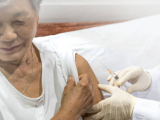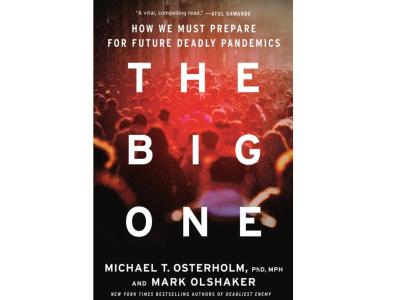Dec 11, 2008 (CIDRAP News) – Half-dose influenza shots generate nearly as strong an immune response in young adults as full-dose shots do, suggesting that cutting the dose in half may be a good way to cope with vaccine shortages, according to a study published this week.
Among adults between the ages of 18 and 49, immune responses in those who received a half dose were not substantially weaker than in those who received full doses, and the responses in women were especially strong, according to the report, published in Archives of Internal Medicine.
In the event of a flu vaccine shortage, using half doses could stretch the supply, write the authors, led by Renata J.M. Engler, MD, of Walter Reed Army Medical Center in Washington, DC. The study was sponsored by the Army, the National Institute of Allergy and Infectious Diseases, and the Centers for Disease Control and Prevention.
"Half-dose TIV [trivalent inactivated vaccine] represents a viable alternative strategy for managing supply shortages to optimize delivery, particularly to critical personnel such as first responders and service members," the report states. TIV vaccine targets three flu strains.
The study is not the first to test the possibility of using half-dose flu vaccines. In a study conducted in the 2000-01 flu season, investigators found that a half-dose shot in adults between 18 and 49 generated immune responses that were "not substantially inferior" to those generated by full-dose vaccine, the new report notes.
The new study was designed to test half-dose vaccination in another season with a different vaccine formulation and in a group that included 50- to 64-year-olds as well as younger adults.
The investigators recruited 1,114 volunteers who had received at least one flu shot in the previous 3 years. The volunteers were enrolled through the US Military Health System in the Washington, DC, area in the fall of 2004. They were grouped by age (18 to 49 and 50 to 64) and sex and randomly assigned to receive a half dose or a full dose of injectable vaccine.
The primary outcome measured was the development of serum hemagglutination inhibition antibody (HAI) titers of 1:40 to the three flu strains used in the vaccine. The researchers also looked for fourfold or greater increases in HAI titer and geometric mean titer, vaccination side effects, and flu-like illnesses resulting in medical encounters.
The percentages of volunteers who had HAI titers of 1:40 or higher after vaccination were somewhat higher for the full-dose group than for the half-dose group. Among the 18- to 49-year-olds, the respective percentages for full dose and half doses of the three flu strains were as follows: influenza A/H1N1, 54.0% and 42.3%; A/H3N2, 75.5% and 67.3%; and influenza B, 82.5% and 77.5%. In the 50- to 64-year-olds, the percentages were as follows: A/H1N1, 38.9% and 23.2%; A/H3N2, 72.5% and 63.0%; and B, 70.7% and 62.0%.
Despite these differences, the statistical standard used by the investigators—the proportion of volunteers with an HAI of 1:40 reduced by no more than 20%—showed there was no "substantial reduction" in immune response for the half-dose volunteers, except in the case of the H1N1 vaccine in the 50- to 64-year-olds.
Further, the researchers found that women tended to have higher responses than men in the same age and dose group, and the geometric mean titers for women given a half dose were about the same as those for men who received a full dose.
As for vaccine side effects, injection-site redness or swelling and joint or muscle pain were more common in the full-dose group than the half-dose group, but other side effects didn't differ by dose group. However, a number of side effects, including injection-site symptoms, joint pain, headache, and fatigue were more common in women than men.
The authors found no differences among the dose and gender groups regarding flu-like illness, medical encounters, and antibiotic use.
The researchers write that their results add to earlier evidence that a 50% dose reduction would be unlikely to generate "substantially inferior" immunity in adults under age 50. The results in the older group were generally similar, but because the geometric mean titers were on the edge of the acceptable range, more research is needed in that area.
The report adds that, in view of the stronger responses in women compared with men, "guidelines for vaccine use during shortages should take sex as well as age into consideration."
In an editorial accompanying the report, Ann R. Falsey, MD, writes that the results support the idea of using half-dose flu vaccines in young women as a way to extend the supply in a shortage.
Falsey says that an antibody titer of 1:40 is "relatively protective," but higher levels are associated with stronger protection from infection and less severe illness. "If more antibodies are better, how much is 'good enough' in a time of critical vaccine shortage?" she writes.
"In trying to stretch vaccine supplies to protect the largest number of persons," she adds, "we must use care to not waste vaccine by using low doses, which will ultimately not be protective. This study clearly shows that half-dose TIV in young healthy women is a rational way to extend vaccine supply in a time of critical shortage."
Flu vaccine is commonly sold in multiple-dose vials and single-dose syringes. John Treanor, MD, of the University of Rochester, senior author of the study, told CIDRAP news that it would not be difficult to provide half doses of flu vaccine when using multi-dose vials.
He said the dose vials contain 5 mL of vaccine, enough for 10 doses of 0.5 mL each. "If you just drew up a quarter of a milliliter, you'd get 20 [half] doses," he added.
"My guess would be that if we were ever in a scenario where we'd have to do this, it would be done by manipulating multi-dose vials," Treanor said.
Engler RJM, Nelson MR, Klote MM, et al. Half- vs full-dose trivalent inactivated influenza vaccine (2004-2005): age, dose, and sex effects on immune responses. Arch Int Med 2008 Dec 8;168(22):2405-14 [Abstract]
Falsey AR. Half-dose influenza vaccine: Stretching the supply or wasting it? (Editorial). Arch Int Med 2008 Dec 8;168(22):2402-3 [Portion]



















